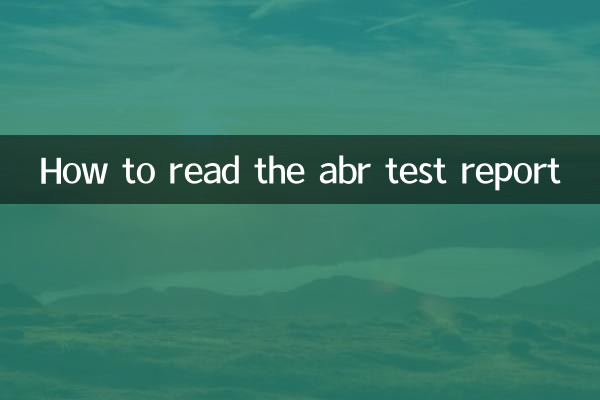How to read the ABR test report sheet
The ABR (Auditory Brainstem Response) test is an electrophysiological examination method commonly used to evaluate hearing function. For many patients, they may feel confused after receiving the ABR test report form and do not know how to interpret the data and results. This article will introduce in detail the components of the ABR test report form and how to correctly interpret it to help you better understand your hearing status.
1. Basic structure of ABR test report sheet

ABR test reports usually include the following parts: basic patient information, test conditions, waveforms, threshold data, and clinical recommendations. The following is an example of structured data for a typical ABR test report:
| project | content |
|---|---|
| patient name | Zhang San |
| gender | male |
| age | 35 years old |
| Test date | 2023-10-10 |
| Test frequency | 500Hz, 1000Hz, 2000Hz, 4000Hz |
| left ear threshold | 20dB HL |
| Right ear threshold | 25dB HL |
| Waveform latency | I wave: 1.5ms, III wave: 3.5ms, V wave: 5.5ms |
| clinical advice | Hearing in both ears is normal, regular review is recommended |
2. How to interpret the ABR test report form
1.Basic patient information: This part includes name, gender, age, etc., and is used to confirm the ownership of the report form.
2.Test conditions: Including test date, test environment, stimulus frequency used, etc. This information is important in assessing the reliability of test results.
3.Waveform graph: The ABR test records the latency and amplitude of each waveform along the auditory pathway. The normal ABR waveform includes I, III, and V waves, and their latency and mutual relationship can reflect the functional status of the auditory pathway.
4.threshold data: This is one of the most important parts of the report sheet, indicating the minimum stimulation intensity that can elicit an ABR response at each frequency. The ABR threshold of normal adults is usually ≤20dB HL.
5.clinical advice: The doctor will give professional diagnostic opinions and follow-up suggestions based on the test results, which is what patients need to pay special attention to.
3. Interpretation of common ABR test results
Here are several common ABR test results and their possible meanings:
| Test results | possible meaning |
|---|---|
| All waveforms are normal, threshold ≤20dB HL | normal hearing |
| Missing or abnormal waveforms, raised thresholds | Possible hearing loss |
| I wave is present, III and V waves are missing | May indicate brainstem disease |
| The incubation period of each wave is extended | May indicate demyelinating disease |
| Unilateral waveform abnormality | May indicate unilateral lesions such as acoustic neuroma |
4. Precautions
1. ABR test results need to be comprehensively judged by professional doctors in combination with clinical symptoms and other examination results. Patients should not make their own diagnosis based on the report sheet alone.
2. The normal values may be different for different age groups, especially the interpretation of ABR results in infants and young children has its particularities.
3. The status during the test (such as whether to cooperate, whether to take medication, etc.) may affect the results. If there are special circumstances, the doctor should be informed.
4. The ABR test mainly reflects the neural function of the auditory pathway and cannot be completely equivalent to the subjective hearing test.
5. Recent hot topics
In the past 10 days, hot topics about hearing health include:
1.Special report on World Hearing Day: Experts call for attention to early hearing screening, especially for newborns and the elderly.
2.Headphone use and hearing loss: Latest research shows that long-term use of headphones at high volumes may cause irreversible hearing damage.
3.Application of Artificial Intelligence in Hearing Testing: Many technology companies have launched AI-based hearing screening apps, but their accuracy still needs to be verified.
4.Progress in the treatment of sudden deafness: New drug treatment options show promising results in clinical trials.
5.Noise pollution and hearing health: The impact of urban noise pollution on hearing has attracted widespread attention.
Understanding how to interpret an ABR test report form is important to taking care of your own hearing health. If you have any questions about the test results, it is recommended to consult a professional doctor promptly to obtain an accurate diagnosis and appropriate treatment recommendations.

check the details

check the details